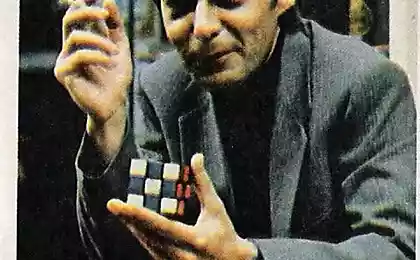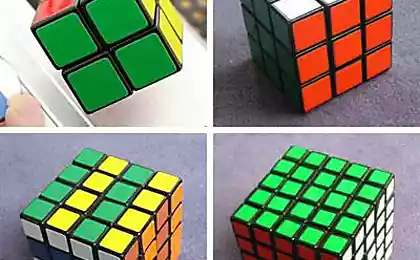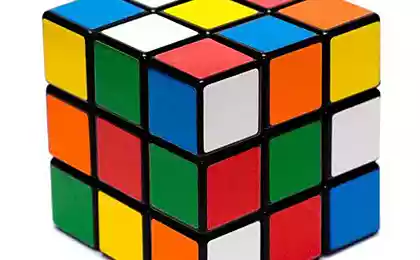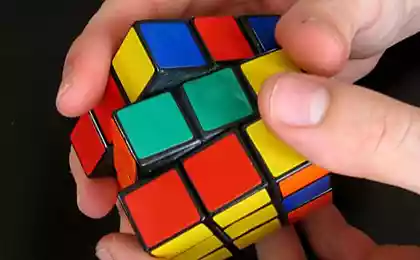976
On the Soviet Rubik's Cube (3 photos)
Rubik's Cube has appeared in the Soviet Union after the Moscow Olympics was that way in 1981, and according to some, the right to release this toy cost the Soviet Union in a considerable amount of time $ 3 million (or rather "petrodollars»).
Initially lucky having this dice in the early '80s, there was not very much - to the one who brought the Cube to school a queue wanting to see what it is. The ability to collect it as it should be then seemed quite incredible. But for those with the Rubik's Cube was not, in 1982, the magazine "Young Technician" published an article with illustrations and drawings entitled "All cube cubes" about how to make it yourself.

But gradually the production of the Rubik's Cube in the USSR more or less adjusted (although he remained a deficit) and soon the Soviet media were full of numerous publications on the topic "What should be done to still collect the damn cube?».
In those days, in the journal "Science and Life" looked very amusing this neighborhood: next to an article about the achievements of Soviet and pulp industry irrigation land left fallow long article - "How to assemble the Rubik's Cube" with its collection of mathematical formulas. They wrote also that there is a secular analogue of the Rubik's Cube - "Moldavian Pyramid" and it is even better because it is easier to collect, but I do not remember.
The first puzzle force felt by teachers - the whole classes purposefully fiercely Cube collected during lessons under their desks. Teachers taking it during the lessons themselves squeaked Dice in the classroom, cut off from apprentice classy magazine. The schools were "closed" championships speed - is a legendary person, who could assemble it in one minute (a speed record, they say, was 26 seconds!) To compete, as a smaller number of moves.
Cube twisted selflessly, detached, right at the Research Institute, lectures, holiday homes and in queues. The public transport was running into a subway car or tram, which Cube twisted to one-third of passengers.
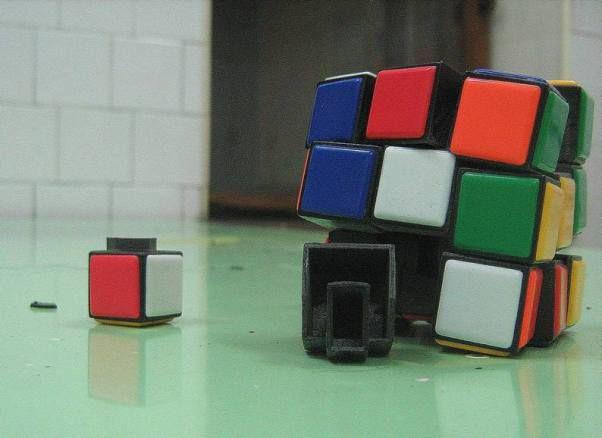
Cubes often broke - with anger, throwing them against the wall and crushed underfoot. According to the observations of British psychiatrists and neurologists, some people more than an hour to no avail wheeled toy in the hands, began to get nervous, angry, people, too unbalanced, become aggressive, they have a desire to break the cube or jaw neighbor.
Joke English psychologist gave twist Rubik apes. Chimpanzees beginning with extreme interest the puzzle, but then began to worry, worry turned into a strong emotion, excitement in anger. One of the monkeys angrily threw the cube from the cell, and the other was trying to eat it, and the third to break into small pieces.
In the USSR the Rubik's Cube was the best gift for all occasions: a birthday, wedding, new home, New Year and ranking Soviet gifts exceeded even if the book (traditionally a gift and a source of knowledge). But some citizens he replaced even love the game because it is assumed similar to the complexity, the playfulness of thought and time hands.
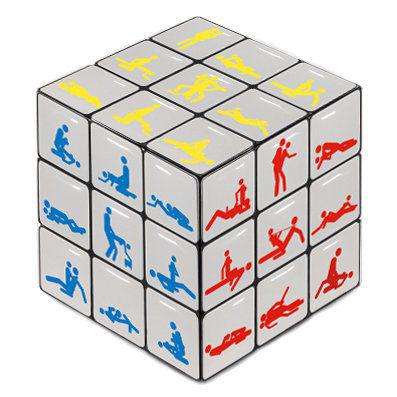
In a family of intellectuals then supposed to have at least two cubes at a time - that no one had to wait impatiently enviously looking at collecting. And it gets the feeling that the Rubik's Cube while not spinning unit. I, for example. As was the family do not consider myself an intellectual, never differed assiduity and the circles in which I was spinning, it was considered a philistine "zapadlo».
And soon a wave of excitement around the World Rubik's Cube itself began to subside, hundreds of millions of bricks were hidden on dusty boxes, and the next generation of Soviet schoolchildren were busy is another cult game of Soviet times - Electronics MI-02 "Well, wait! or "The wolf catches eggs. '"
Initially lucky having this dice in the early '80s, there was not very much - to the one who brought the Cube to school a queue wanting to see what it is. The ability to collect it as it should be then seemed quite incredible. But for those with the Rubik's Cube was not, in 1982, the magazine "Young Technician" published an article with illustrations and drawings entitled "All cube cubes" about how to make it yourself.

But gradually the production of the Rubik's Cube in the USSR more or less adjusted (although he remained a deficit) and soon the Soviet media were full of numerous publications on the topic "What should be done to still collect the damn cube?».
In those days, in the journal "Science and Life" looked very amusing this neighborhood: next to an article about the achievements of Soviet and pulp industry irrigation land left fallow long article - "How to assemble the Rubik's Cube" with its collection of mathematical formulas. They wrote also that there is a secular analogue of the Rubik's Cube - "Moldavian Pyramid" and it is even better because it is easier to collect, but I do not remember.
The first puzzle force felt by teachers - the whole classes purposefully fiercely Cube collected during lessons under their desks. Teachers taking it during the lessons themselves squeaked Dice in the classroom, cut off from apprentice classy magazine. The schools were "closed" championships speed - is a legendary person, who could assemble it in one minute (a speed record, they say, was 26 seconds!) To compete, as a smaller number of moves.
Cube twisted selflessly, detached, right at the Research Institute, lectures, holiday homes and in queues. The public transport was running into a subway car or tram, which Cube twisted to one-third of passengers.

Cubes often broke - with anger, throwing them against the wall and crushed underfoot. According to the observations of British psychiatrists and neurologists, some people more than an hour to no avail wheeled toy in the hands, began to get nervous, angry, people, too unbalanced, become aggressive, they have a desire to break the cube or jaw neighbor.
Joke English psychologist gave twist Rubik apes. Chimpanzees beginning with extreme interest the puzzle, but then began to worry, worry turned into a strong emotion, excitement in anger. One of the monkeys angrily threw the cube from the cell, and the other was trying to eat it, and the third to break into small pieces.
In the USSR the Rubik's Cube was the best gift for all occasions: a birthday, wedding, new home, New Year and ranking Soviet gifts exceeded even if the book (traditionally a gift and a source of knowledge). But some citizens he replaced even love the game because it is assumed similar to the complexity, the playfulness of thought and time hands.

In a family of intellectuals then supposed to have at least two cubes at a time - that no one had to wait impatiently enviously looking at collecting. And it gets the feeling that the Rubik's Cube while not spinning unit. I, for example. As was the family do not consider myself an intellectual, never differed assiduity and the circles in which I was spinning, it was considered a philistine "zapadlo».
And soon a wave of excitement around the World Rubik's Cube itself began to subside, hundreds of millions of bricks were hidden on dusty boxes, and the next generation of Soviet schoolchildren were busy is another cult game of Soviet times - Electronics MI-02 "Well, wait! or "The wolf catches eggs. '"
